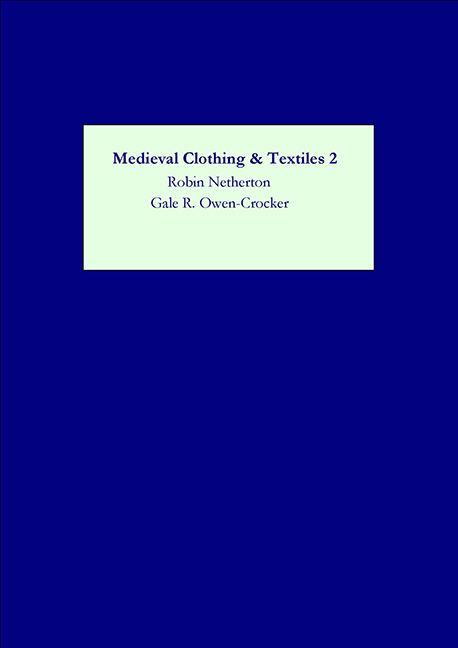Book contents
- Frontmatter
- Contents
- Illustrations page
- Tables
- Contributors
- Preface
- 1 Dress and Accessories in the Early Irish Tale 'The Wooing Of Becfhola”
- 2 The Embroidered Word: Text in the Bayeux Tapestry
- 3 “De Fil d'Or et de Soie”: Making Textiles in Twelfth-Century French Romance
- 4 Biffes, Tiretaines, and Aumonières: The Role of Paris in the International Textile Markets of the Thirteenth and Fourteenth Centuries
- 5 'Clothing Themselves in Acres”: Apparel and Impoverishment in Medieval and Early Modern England
- 6 'Ye Shall Have It Cleane”: Textile Cleaning Techniques in Renaissance Europe
- 7 Fleas, Fur, and Fashion: Zibellini as Luxury Accessories of the Renaissance
- 8 The Matron Goes to the Masque: The Dual Identity of the English Embroidered Jacket
- Recent Books of Interest
- Index
3 - “De Fil d'Or et de Soie”: Making Textiles in Twelfth-Century French Romance
Published online by Cambridge University Press: 14 February 2019
- Frontmatter
- Contents
- Illustrations page
- Tables
- Contributors
- Preface
- 1 Dress and Accessories in the Early Irish Tale 'The Wooing Of Becfhola”
- 2 The Embroidered Word: Text in the Bayeux Tapestry
- 3 “De Fil d'Or et de Soie”: Making Textiles in Twelfth-Century French Romance
- 4 Biffes, Tiretaines, and Aumonières: The Role of Paris in the International Textile Markets of the Thirteenth and Fourteenth Centuries
- 5 'Clothing Themselves in Acres”: Apparel and Impoverishment in Medieval and Early Modern England
- 6 'Ye Shall Have It Cleane”: Textile Cleaning Techniques in Renaissance Europe
- 7 Fleas, Fur, and Fashion: Zibellini as Luxury Accessories of the Renaissance
- 8 The Matron Goes to the Masque: The Dual Identity of the English Embroidered Jacket
- Recent Books of Interest
- Index
Summary
Cloth and clothing held a privileged place in the romances of twelfth-century France. The writers from this period, which marked the birth of romance as a literary genre, used textiles in a great many ways and for a great many narrative purposes, providing lengthy descriptions of characters' clothing, depicting scenes of dressing and undressing, and even including scenes in which characters make cloth. Yet cloth and clothing do not appear to be simply ornaments in these literary works. Cloth and clothing were so important for these writers, and the writers were able to use them so inventively, precisely because textile had a special relationship both with the society of the day and with the new literary conventions that emerged with the rise of romance. Moreover, an examination of some textual instances that depict the production of textiles—or, in some cases, the refusal to produce them—shows how changing social norms about the gender roles in textile production created ambivalence in both society and literature.
The making of clothing and fabric was of tremendous importance for medieval society: It helped form and solidify complex social bonds, both within families,
A version of this paper was presented in May 2004 at the International Congress on Medieval Studies at Kalamazoo, Michigan.
especially from generation to generation, and among different families. Gifts of cloth and clothing, among other valuables, created these social ties, while the manufacture of cloth was often a shared experience. It is indeed no surprise that today we still refer metaphorically to the “fabric of society.” The industries providing the raw materials for cloth production included a great variety of different vocations, starting with farming, raising livestock, and manufacturing dyestuffs. Merchants and traders transported goods to where they were needed. Production required the work of spinners, weavers, dyers, finishers, and other skilled and unskilled laborers. The people involved in these commercial relationships were diverse, from different backgrounds and social classes and both sexes. In a very real sense, therefore, cloth bound society together.
Traditionally, spinning, weaving, cutting, and sewing fell into the domain of women's work. Yet, by the mid-twelfth century, a slow, complex shift had begun to occur. As cloth production was steadily becoming an industry of professionals and thus increasingly organized, and as the technology that supported such production was advancing and becoming more complicated, men began to take over certain formerly female-dominated occupations within the manufacturing process.
- Type
- Chapter
- Information
- Medieval Clothing and Textiles 2 , pp. 61 - 72Publisher: Boydell & BrewerPrint publication year: 2006



